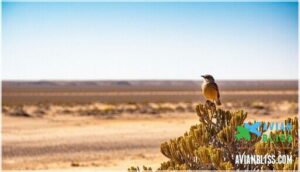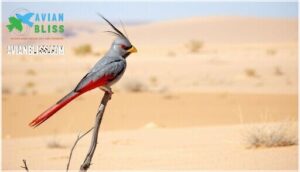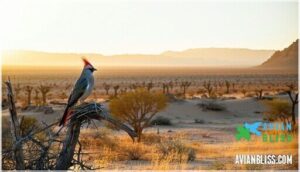This site is supported by our readers. We may earn a commission, at no cost to you, if you purchase through links.
 A gray ghost with a crimson blush moves through the mesquite—silent, purposeful, perfectly at home where few birds dare to linger. Often mistaken for its famous cousin, the Northern Cardinal, this desert specialist has carved out a niche in the thorny scrublands of the Southwest with adaptations most songbirds can’t match.
A gray ghost with a crimson blush moves through the mesquite—silent, purposeful, perfectly at home where few birds dare to linger. Often mistaken for its famous cousin, the Northern Cardinal, this desert specialist has carved out a niche in the thorny scrublands of the Southwest with adaptations most songbirds can’t match.
The pyrrhuloxia thrives in scorched landscapes where temperatures climb past 100°F and water becomes a rare luxury. Its curved, parrot-like bill cracks seeds other birds abandon, and its muted plumage provides camouflage against sun-bleached earth.
Yet despite these exceptional survival skills, pyrrhuloxia populations have quietly declined by more than half in recent decades—a warning sign from one of the desert’s most resilient residents.
Table Of Contents
- Key Takeaways
- What is a Pyrrhuloxia Bird?
- Physical Characteristics of Pyrrhuloxia
- Pyrrhuloxia Habitat and Distribution
- Pyrrhuloxia Behavior and Diet
- Pyrrhuloxia Nesting and Conservation Status
- Frequently Asked Questions (FAQs)
- Where is pyrrhuloxia found?
- What is the difference between cardinals and pyrrhuloxia?
- Is pyrrhuloxia endangered?
- What does a female pyrrhuloxia look like?
- What are common predators of the pyrrhuloxia?
- How do pyrrhuloxias cope with extreme temperatures?
- Can pyrrhuloxias thrive in urban environments?
- What is the lifespan of a pyrrhuloxia?
- Do pyrrhuloxias participate in migratory movements?
- How long do Pyrrhuloxia birds typically live?
- Conclusion
Key Takeaways
- The pyrrhuloxia survives extreme desert conditions through specialized adaptations like a curved, parrot-like bill that cracks tough seeds, efficient water extraction from food sources, and gray camouflage plumage that blends with arid scrubland.
- Despite being resilient desert specialists, pyrrhuloxia populations have declined by more than 50% over the past five decades due to habitat loss from agricultural expansion and urban development, earning them a spot on the 2025 State of the Birds ‘Tipping Point’ watch list.
- This bird differs from its Northern Cardinal cousin through distinct physical traits—males display gray plumage with strategic red accents rather than all-red coloring, and both sexes have shorter, curved yellow bills instead of straight reddish ones.
- You can support pyrrhuloxia conservation by creating desert-friendly backyards with native plants like mesquite, providing reliable water sources, offering ground-level feeders with sunflower seeds, and participating in citizen science programs like the Christmas Bird Count.
What is a Pyrrhuloxia Bird?
You might spot a Pyrrhuloxia and mistake it for a cardinal, but this desert dweller has carved out its own niche in the Southwest’s harshest landscapes.
Understanding what makes this species unique starts with knowing its scientific background, how it differs from its famous cardinal cousin, and what special tricks it uses to thrive where others can’t.
Let’s break down the essentials of this notable desert bird.
Scientific Classification and Common Names
You might know the Pyrrhuloxia as the desert cardinal, but its scientific name—Cardinalis sinuatus—tells you it belongs to the same genus as its more famous cousin, the Northern Cardinal. The species name "sinuatus" refers to the curved edge of its bill. You’ll find this bird classified in the family Cardinalidae within standard taxonomy systems.
Understanding bird nomenclature helps you identify species more accurately when you’re observing these striking desert songbirds in their natural habitat.
Pyrrhuloxia Vs. Northern Cardinal
These close relatives often confuse birdwatchers. Male Pyrrhuloxias are gray with red accents, while male Northern Cardinals are entirely bright red with black masks. Their bills offer the clearest distinction—Pyrrhuloxias display short, curved yellow bills built for cracking tough seeds, whereas Northern Cardinals have larger, straight red-orange bills.
You’ll notice size differences too: Northern Cardinals measure 8 to 9 inches and weigh 42 to 48 grams, while Pyrrhuloxias average 7.5 to 8.3 inches at 24 to 43 grams. Song patterns overlap considerably, making vocal identification challenging in habitat overlap zones across southern Arizona, New Mexico, and Texas. The Pyrrhuloxia’s breeding habits can be found in the Texas breeding areas of its range.
Unique Adaptations to Arid Environments
Surviving where water is scarce requires tools most birds don’t have, and the Pyrrhuloxia’s powerful, curved bill is its secret weapon against the desert’s harsh terms. You’ll find this arid habitats specialist thriving through these key adaptations:
- Water Conservation – extracting moisture from seeds and cactus fruits
- Desert Camouflage – gray plumage blending with thorny scrub
- Drought Tolerance – surviving extended dry periods
- Adaptive Migration – wandering to better resources in winter
These features showcase the conservation of species through adaptation to environment in desert habitat conditions.
Physical Characteristics of Pyrrhuloxia
You’ll recognize a Pyrrhuloxia by its stocky build and distinctive silhouette. This desert cardinal measures 7.5 to 8.5 inches long and sports a tall, spiky crest paired with a thick, curved bill that’s built for cracking seeds.
Here’s what you need to know to identify one in the field.
Size and Weight
Pyrrhuloxias measure between 7½ and 8½ inches in length, placing them in the same size range as their close relative, the Northern Cardinal. Their body mass usually ranges from 24 to 40 grams.
You’ll notice their stocky build and balanced proportions make them well-suited for desert life. Wing length and beak size contribute to their distinctive silhouette, helping you distinguish this species during bird identification in arid habitats.
Male and Female Appearance
When you spot a Pyrrhuloxia, the difference between males and females catches your eye immediately. Males wear gray plumage with vivid red accents on their face, crest, wings, and tail. Females show buff-gray tones with subtle reddish tinges.
Gender Differences include:
- Male Pyrrhuloxias display bold crimson facial patches and breast centers
- Female Pyrrhuloxias exhibit muted coloration with minimal red highlights
- Both sexes share the distinctive curved yellow-orange beak
- Crest styles remain spiky and prominent regardless of gender
- Color variations intensify in males during breeding season
Distinctive Features and Color Patterns
You’ll recognize a Pyrrhuloxia by its parrot-like bill—that thick, curved yellow-orange beak sets it apart from nearly every other songbird in the Southwest. The plumage blends gray tones with strategic red highlights, creating a color pattern that’s both subtle and striking.
That thin, spiky crest stands upright when the bird’s alert. The feather textures appear smooth yet structured, with red accents concentrated along the wings, breast center, and tail edges—avian characteristics perfectly suited for desert camouflage.
Seasonal Plumage Changes
Unlike most desert songbirds, Pyrrhuloxias don’t undergo dramatic seasonal plumage transformations—the gray and red pattern you see in winter looks nearly identical come spring. Males maintain their vivid red accents year-round, though breeding plumage may appear slightly brighter.
The molting process occurs gradually after nesting season. Color variation among individuals relates more to age and plumage health than seasonal camouflage.
This consistency makes bird identification reliable across seasons for this avian species.
Pyrrhuloxia Habitat and Distribution
The Pyrrhuloxia thrives where many birds wouldn’t dare to call home. You’ll find this desert cardinal scattered across the American Southwest and into Mexico, where it’s carved out a niche in some of the region’s harshest terrain. Understanding where these birds live helps you know where to look for them.
Preferred Habitats in The Southwest
If you’re looking for this gray-and-red desert dweller, you’ll want to focus on thorny brush and streamside thickets where the Southwest’s driest landscapes meet dense vegetation.
Pyrrhuloxias thrive in arid ecosystems dominated by mesquite forests, thorn scrub, and canyon habitats. You’ll spot them in dry woodlands and desert landscapes that offer protective cover—places where dense, spiny vegetation creates shelter in otherwise harsh terrain.
These desert ecosystems provide everything they need for survival in the Southwest’s unforgiving climate.
Range in The United States and Mexico
The Pyrrhuloxia bird species spans southwestern United States and northern Mexico, creating a unique border migration pattern tied to desert corridors. These birds, often referred to as desert cardinals, are found across southern Arizona, New Mexico, and the southern half of Texas, where their geographic range reaches peak density.
In Mexico, the Pyrrhuloxia’s habitat and range cover the Chihuahuan Desert, extending through Sonora and Sinaloa. These Mexican habitats support three distinct subspecies. In the United States, range expansion is occurring northward, particularly in areas where mesquite vegetation increases. However, geographic isolation limits broader distribution.
The Pyrrhuloxia’s preferred desert habitats play a vital role in its migration and survival.
Upland Vs. Lowland Desert Preferences
Desert-dwelling Pyrrhuloxias show a clear preference for upland regions over the scorching lowland deserts that dominate southwestern Arizona. You’ll find these birds thriving where elevation and vegetation meet their needs:
- Upland habitats with mesquite and acacia provide cooler microclimates and dense cover
- Desert elevation between 1,000-4,000 feet offers ideal terrain preferences for foraging
- Arid regions with thorny scrub create protective nesting sites in desert ecosystems
This habitat and range selection helps Pyrrhuloxias avoid extreme heat stress in arid landscapes.
Adaptation to Human-Altered Landscapes
While Pyrrhuloxias naturally favor untouched brush country, they’ve proven surprisingly flexible when homes and farms reshape their desert territory. You’ll spot them in backyards with water features and native plantings, demonstrating their adaptive strategies despite habitat loss and urbanization pressures.
This ecosystem resilience helps offset landscape fragmentation impacts, though conservation efforts remain critical for desert ecosystem protection. Their urban habitat use shows that even moderate human impact doesn’t always eliminate species when core vegetation survives.
Pyrrhuloxia Behavior and Diet
Understanding how the Pyrrhuloxia behaves gives you insight into its survival strategies in harsh desert conditions. You’ll notice distinct patterns in how these birds move, feed, and communicate throughout the year.
Let’s explore the key aspects of their daily lives and dietary preferences.
Social Structure and Seasonal Movements
You’ll often spot these gray-and-red birds in small flocks during winter, a sharp contrast to their more solitary breeding season behavior. Unlike the sedentary Northern Cardinal, Pyrrhuloxias are social birds that wander beyond their breeding territories once nesting ends.
Winter roosts can hold dozens of individuals, and you’ll notice flock dynamics shift as they move through arid landscapes seeking food and water.
Foraging Habits and Food Sources
These birds spend most of their day hopping along the ground, using their thick, curved bills to crack open seeds and snatch insects from the soil. You’ll watch them move into low vegetation to pick beetles and caterpillars from leaves, or even sally into the air to catch a grasshopper mid-flight.
Their diet shifts seasonally—insects dominate spring and summer menus, while seeds from pigweed and grasses sustain them through winter. They’ll also sip nectar from blooming cactus flowers.
Key food sources include:
- Seeds from mesquite, sorghum, and native grasses
- Insects like beetles, caterpillars, grasshoppers, and cicadas
- Desert fruits and berries from native plants
- Cactus nectar during flowering periods
Song, Calls, and Communication
Beyond feeding, vocal signals bind these desert cardinals together. Males belt out sharp, melodious whistles from exposed perches to mark territory and attract mates. You’ll hear call patterns shift from metallic chirps to softer contact notes as pairs forage. Their acoustic signals mirror Northern Cardinal vocalizations but with drier, raspier tones—a key trait for Pyrrhuloxia identification.
| Vocalization Type | Function |
|---|---|
| Melodious whistles | Territory defense, mate attraction |
| Sharp chirps | Alarm calls, flock coordination |
| Soft contact notes | Pair bonding, foraging communication |
Attracting Pyrrhuloxia to Backyards
If you want these striking desert birds visiting regularly, start by setting up a reliable water source—think shallow birdbaths or dripping fountains that mimic natural desert seeps.
Ground-level bird feeders stocked with sunflower seeds work wonders, especially near native plants like mesquite or prickly pear.
Desert landscaping with fruiting cactus creates a backyard habitat that sustains Pyrrhuloxia year-round while advancing desert habitat preservation and rewarding your bird watching efforts with close encounters.
Pyrrhuloxia Nesting and Conservation Status
Understanding the Pyrrhuloxia’s nesting behavior and current conservation status helps you appreciate both its resilience and vulnerability in the Southwest’s changing landscape. The species faces real challenges from habitat loss, yet it continues to adapt to life alongside humans.
Here’s what you need to know about their breeding habits and how their populations are faring today.
Nesting Habits and Breeding Season
From late February through August, these striking desert cardinals shift their focus from wandering flocks to establishing territories and raising their young. The female selects a nesting site in dense brush or thorny vegetation, constructing the nest alone using bark strips, grass, and rootlets, and lining it with soft materials. Nests are usually placed on outer branches away from the main trunk.
Key aspects of Pyrrhuloxia nesting habits:
- Territory establishment begins in late February as pairs separate from winter flocks
- Nest construction takes place in mesquite, acacia, or other thorny desert plants for protection
- Breeding seasons span March through August, allowing multiple nesting attempts
- Male participation includes territorial defense through song while females build nests
- Nest placement favors flimsy outer branches that predators find difficult to access
Egg Characteristics and Chick Rearing
Each clutch contains two to four pale green eggs adorned with subtle gray and brown markings that help camouflage them among the thorny desert vegetation.
Both parents share feeding duties, bringing insects and occasional cactus fruits to their nestlings. The chicks develop rapidly on this protein-rich diet, leaving the nest approximately 10 days after hatching, though they’ll continue receiving parental care as fledglings while learning to forage independently in their desert home.
Population Trends and Threats
Over the past 50 years, Pyrrhuloxia populations have plummeted by more than 50%, earning them a spot on the 2025 State of the Birds ‘Tipping Point’ watch list. Though their conservation status remains ‘Least Concern’, species vulnerability is mounting due to:
Pyrrhuloxia populations have crashed by over 50% in five decades, pushing this desert cardinal onto the ‘Tipping Point’ watch list despite its official ‘Least Concern’ status
- Habitat fragmentation from agriculture and urban sprawl across millions of southwestern acres
- Climate shifts threatening drought-stressed food resources and breeding success
- Brood parasitism by cowbirds affecting 13% of monitored nests
- Population decline continuing at approximately 1% annually since 1967
This avian conservation status signals urgent need for habitat and range protection.
Conservation Efforts and How to Help
Multiple groups are working to reverse the decline. The Rio Grande Joint Venture protects over 2.5 million acres of priority bird habitat across the Southwest. Since 2020, habitat restoration projects have planted tens of thousands of mesquite and native trees annually. Conservation funding exceeds $2 million since 2020, supporting biodiversity preservation and ecological conservation.
You can help through volunteer opportunities like the Christmas Bird Count, which logs over 5,000 Pyrrhuloxia records each winter. Create bird-friendly gardens with native plants—over 12,000 properties joined Audubon’s program in 2024. Support wildlife conservation by advocating for local preservation laws, which led to two new mesquite protection ordinances in 2023. Community engagement makes a real difference for this species’ conservation status.
Frequently Asked Questions (FAQs)
Where is pyrrhuloxia found?
Like a compass pointing to the driest corners of the map, you’ll find this desert cardinal in Southwest regions spanning Arizona, New Mexico, southern Texas, and northern Mexico.
It thrives in arid landscapes with mesquite, thorn scrub, and dry country habitats.
What is the difference between cardinals and pyrrhuloxia?
Cardinals and Pyrrhuloxias look similar but differ in key ways. Pyrrhuloxias have curved yellow bills and gray plumage with red accents. Cardinals sport straight reddish bills and vibrant all-over red coloring in males.
Pyrrhuloxias prefer drier desert habitats while Cardinals favor wetter woodlands.
Is pyrrhuloxia endangered?
No, Pyrrhuloxia aren’t endangered. You’ll find them listed as Least Concern by the IUCN.
However, their numbers have dropped over 50% since the 1960s due to habitat loss from development and farmland expansion across their southwestern range.
What does a female pyrrhuloxia look like?
You’ll notice the female has buff-gray plumage with subtle red tinges on her wings, crest, and tail feathers. Her curved yellow-orange beak stands out against her muted gray body, making field identification easier than you’d expect.
What are common predators of the pyrrhuloxia?
In survival’s chess match, desert nesting birds must outwit hungry opponents.
Nesting Safety faces threats from feral cats, domestic cats, Ferruginous Pygmy-Owls, and Greater Roadrunners.
Predator Avoidance through dense mesquite provides critical protection.
How do pyrrhuloxias cope with extreme temperatures?
Desert adaptation allows these birds to tolerate arid environments and harsh conditions. Pyrrhuloxia rely on thermoregulation through evaporative cooling and behavioral strategies.
Their heat tolerance and cold resistance demonstrate climate resilience as a true desert cardinal facing harsh environments.
Can pyrrhuloxias thrive in urban environments?
You’ve probably heard cities are no place for desert birds. Not quite true. These gray-and-red songbirds can adapt to urban environments if you create wildlife-friendly spaces.
They’ll visit backyards with desert landscaping, water features, and backyard feeders stocked with sunflower seeds.
What is the lifespan of a pyrrhuloxia?
Studies on average longevity remain limited for this bird species. Most mortality rates occur during the aging process within their first years.
Pyrrhuloxias generally live up to 8 years in the wild, influenced by survival strategies related to habitat quality, predation, and food availability.
Do pyrrhuloxias participate in migratory movements?
You might think these desert birds are homebodies, but they do move around. Pyrrhuloxias aren’t true migrants, but they show seasonal movements and flocking behavior.
Winter brings wandering flocks away from nesting territories into different habitats, sometimes with altitudinal shifts to lower elevations.
How long do Pyrrhuloxia birds typically live?
Wild populations face numerous mortality risks from predators, harsh climate conditions, and limited resources.
Longevity studies for desert-dwelling songbirds indicate survival strategies that balance breeding success with environmental challenges. Based on similar cardinal species patterns, you can expect this desert specialist to reach eight to ten years under favorable conditions.
Conclusion
Sure, the pyrrhuloxia will save the desert—right after we finish paving it. This unassuming bird asks only for thorny scrub and seed-rich ground, yet we’ve managed to halve its numbers while barely noticing.
If you want to spot one before they vanish into memory, learn their curved bill, their metallic chip call, and the mesquite thickets they refuse to abandon. Then plant native shrubs, skip the pesticides, and leave water out. The desert’s gray ghost doesn’t need applause—just a fighting chance to stay.










